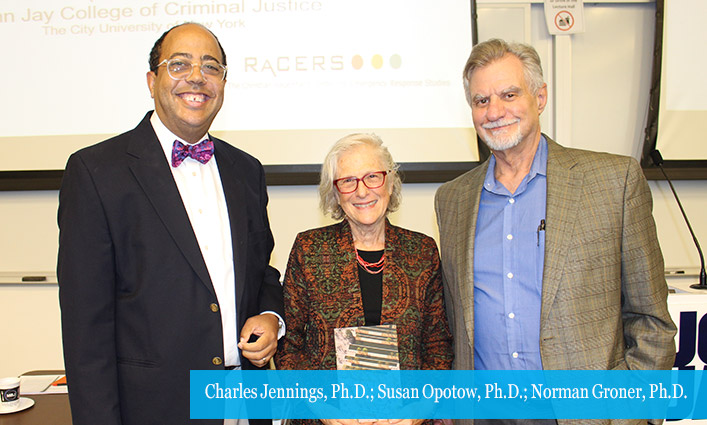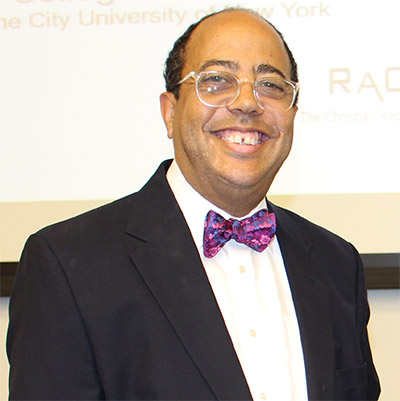
It’s been 18 years since the tragic events on September 11, 2001, and to this day, New York City is still dealing with the impact of the attacks. On October 17, the Sociology Department, hosted a book talk for New York After 9/11, touching on the lessons that were learned, and how New York can better prepare for any future incidences. Susan Opotow, Ph.D., Professor in the Sociology Department and one of the book’s editors, began the talk by asking the audience a few questions. “How many of you remember 9/11? How many of you heard about it through family? Through the news or in school?” she asked. “Regardless of where you were on September 11, whether you were born or not, what happened that day has been engrained in our City’s history and will continue to affect each generation to come.” She continued, reading an excerpt from the book.
“Regardless of where you were on September 11, whether you were born or not, what happened that day has been engrained in our City’s history and will continue to affect each generation to come.” —Susan Opotow
“An estimated two billion people around the world watched the destruction of the World Trade Center [WTC] unfold. Although everyone watching understood that a momentous event was taking place before their eyes, what happened next is far less clear,” said Opotow. “This book is based on the premise that we are still living in the aftermath of 9/11. It reveals how we got from there to the present and what we need to know to understand the past and move forward.” She went on to introduce two contributors of the book and fellow presenters, Charles Jennings, Ph.D., Professor in the Department of Security, Fire, and Emergency Management and Director of the Christian Regenhard Center for Emergency Response Studies and Norman Groner, Ph.D., Professor Emeritus in the Department of Security, Fire, and Emergency Management.

Securing New York City
According to Jennings, one of the biggest changes to come from 9/11 was the creation of CIMS, or the Citywide Incident Management System. CIMS, which was designed to be compliant with the National Incident Management System (NIMS), the federal guideline for handling emergencies, established the roles and responsibilities for the New York Police Department (NYPD) and the Fire Department of the City of New York (FDNY) and defined how emergencies would be handled. “In the case of hazardous materials response, for example, the NYPD was designated the lead agency until such time that the incident was determined not to be the result of a terrorist or criminal act,” said Jennings, explaining one of CIMS’ decisions.
Jennings went on to mention that before CIMS was approved, there was a hearing with expert opinions, to figure out if the system would be beneficial for the City’s response to emergencies. And in 2004, CIMS was officially adopted. Under CIMS, the FDNY became responsible for search and rescue, fire suppression, and arson investigations. Along with responding to hazardous waste, the NYPD was named the lead agency in handling law enforcement and investigation, water search and rescue, VIP protection, evacuation, and site management. “The adoption of CIMS has vastly improved coordination and communications between the City’s agencies,” said Jennings. “And now we are more equipped to handle future emergencies and provide proper protection to the City.”

Protecting Our Buildings
Prior to 9/11, there was no need to worry about what to do in the event of a tall building being on fire. But according to Groner, the possibility of these incidences happening became more apparent after the attacks, as the fear of working in tall buildings increased. “Changes in safety practices typically follow tragic events, so it came as no surprise that tall building safety was scrutinized extensively following the World Trade Center attacks,” he said. To alleviate these fears, the National Institute of Standards and Technology (NIST) investigated the collapse of the towers and made recommendations for building code changes. “The International Code Council [ICC], who is responsible for writing the International Building Code [IBC] and the International Fire Code, and the National Fire Protection Association [NFPA], who is responsible for the Life Safety Code, the Uniform Fire Code, and the Uniform Building Code, responded to NIST’s investigation by establishing committees to make recommendations in response to 9/11.” The result of the committee led to five major changes to the previously established IBC, the adopted building code in the United States.
The first change was the elimination of scissor stairs. “Scissor stairs save space by placing two stairs in the same enclosure,” he said. “Although they usually have a remote entrance and they are often separated only by fire or smoke resistant partitions, these stairs are vulnerable to explosions that can destroy the partitions, rendering both stairs unusable.” The second change was the addition of self-luminous exit pathways. According to Groner, “evacuations from tall buildings can take hours often exhausting backup power supplies that illuminate exit stairs and pathways,” as seen with the 1993 bombing of the WTC. Now building codes mandate that stairs include photoluminescent tapes and paints that can remain visible for several hours.
The addition of a third stairway in buildings over 420 feet was the third code change. The idea is that having additional stairs will decrease evacuation time and allow for occupants to exit the building safely. The fourth change was the most revolutionary, adding emergency occupant evacuation elevators. Before 9/11 there were inherent risks to using elevators during fires, and even today there are signs directing people to avoid them, but the events on 9/11 showed that elevators can save lives. “An estimated two hundred occupants in WTC one and WTC two died in elevators on 9/11. But despite their hazards, the investigation of the WTC towers evacuations revealed that many lives were saved because of elevators that sped up the vertical travel of building occupants,” said Groner. “The large numbers of occupants who survived the WTC attacks because they used elevators gave impetus to a renewed interest in the design of elevators that could be safely used during fire emergencies.”
In 2005, the American Society of Mechanical Engineers created a committee to devise regulatory requirements for elevators that would be safe to use during fires. Some requirements were that signs be posted explaining their usage during emergencies, elevator lobbies have to be equipped with two-way communications to fire command centers, access to exit stairs has to be provided from elevator lobbies, and there must be software within the elevators that allows it to make express trips between floors and the ground level. And the last code change is fire-service access elevators—elevators used by emergency responders to reach the location of the fire more easily—which would have the same requirement as emergency occupant evacuation elevators.

Dealing with the Aftermath
Wrapping up the book talk, Opotow spoke about how the book was inspired by a study she conducted with Zachary Baron Shemtob, co-editor of New York After 9/11. To conduct the study Opotow looked at the New York Times, collecting over 3,000 articles which focused on the aftermath of the attacks. “The book’s focus on specific spheres of urban life emerged from a qualitative study my students and I conducted from 2001 to 2006 utilizing post-9/11 New York City news articles to identify emerging issues after 9/11,” said Opotow. “Key spheres we identified included public safety, physical and mental health, rebuilding, Islamophobia, and memorializing the past.” Focusing specifically on health after 9/11, Opotow mentioned how people were exposed to toxins. “An estimated 400,000 people—first responders, volunteers, Lower Manhattan workers, residents, children, and construction workers—were exposed to toxins resulting from the rapid collapse and disintegration of the Twin Towers,” she said. “This produced a rolling dust cloud containing cement, gypsum, asbestos, glass fibers, calcium carbonate, lead, and other metal particles. In the months and years since, more than 2,000 people have died in addition to the almost 3,000 people who died on 9/11.”
“It is also our hope that as contemporary memories becomes history, the chapters in this book will speak to future generations as well.” —Susan Opotow
Honoring those who have passed, one of the visible tributes to 9/11 is the 9/11 Memorial and Museum. Opening in May 2014—12 years after the attacks—the Memorial Museum is meant to “offer city residents and visitors a place to reflect on the traumatic past.” The site has four key elements, an entry pavilion, a void located below the plaza, and two exhibition spaces within the void. An important feature of this site, is Foundation Hall, which is located almost 70 feet from street level. “When tons of debris were finally removed from the site of 9/11, this void was all that remained. Its open space contains objects connected with the site, including the bedrock in which the Twin Towers were anchored,” said Opotow. One of these features is a steel beam—the last one to be cut down after the nine-month recovery and cleanup process. The museum also includes photos of those who lost their lives that day, video and audio recordings, and artifacts from the towers. Finishing her presentation, Opotow left the audience with a message of hope. “Not only will the September 11 Memorial and Museum increasingly represent the historical, physical, and emotional past of September 11 for future generations, but it is also our hope that as contemporary memories becomes history, the chapters in this book will speak to future generations as well.”



